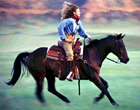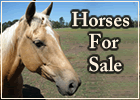

Despooking
Before starting despooking sessions make sure you have taught her several control exercises on a lead rope. On the ground you should be able to back her up by wiggling the rope, move her hindquarters and shoulders independently left and right with very light pressure. You should be able to send her forward around you (lungeing) at walk and trot both directions. For a full description of our ground exercise program see our DVD, Six Keys to Harmony, at http://www.eddabney.com/video.htm When she is responding lightly to your requests for all these movements then you are ready to progress to despooking with confidence of being able to control her movement during the process.
When working on despooking, you should be in a round pen or small paddock with good, safe fences. Have her on a halter and a 12 foot lead rope and allow her to move her feet in a circle around you. Keep tipping her nose back toward you so she stays bent around you. If she moves her nose away from you she can run away or drag you around the corral. Start your despooking with just a towel. It moves but doesn't make noise. Keep it small in your hand and use it to rub her like a brush. Bring it first to her withers then branch out to her neck, shoulder and top line. This is the place that a horse can most easily accept a new item touching them. This is the area where horses touch each other for mutual grooming. Don't go to the nose first. Horses are often frightened there by a new smell or something touching their sensitive muzzle.
Stand near her shoulder. If you are on her left side keep the lead rope fairly short and coming across your left palm and crook of your thumb with your hand open and rubbing her on the upper neck. This keeps your left elbow high to block her from biting you plus your open hand rubbing her neck is a reassuring touch for her and you will be able to feel when she tenses up. Your lead rope is in your left hand with very little slack between your hand and the halter so if she gets scared and starts to leave you can turn her nose back toward you and have her circle around you instead of bolting away. With your right hand you will be rubbing the scary item on her with slow easy rhythm and lots of retreat, taking it away when she is standing calmly accepting it. Use lots of approach and retreat with the scary items. When she is calm with it then slowly let the towel, bag, etc. become larger and move faster. Do all this on both sides of the horse. Do not flop it over to her other side unless you have already introduced it over there otherwise she may be frightened seeing it from her other eye and jump toward you.
Your goal in all despooking is that you never frighten her to the point that her feet move. Your job is to build her courage and to increase her trust in you, not to make her afraid. This means you must go extremely slow (not sneaky but casual) and small with lots of retreat when she is calmly accepting. You should pay close attention and be able to read the horse’s body language and energy. The horse will send some signals before she bolts such as heightened energy, head up, muscles tense, looking away, etc. You need to stay under that threshold of fear and retreat before the horse bolts.
If she becomes frightened and begins to move then you made a mistake by letting the item move too fast, be too loud or too big. If she does move away then you must keep the item in generally the same position it was in when she moved so she learns that moving away does not make the scary item disappear. Only standing calmly makes the scary item disappear. In all horse training the learning is in the release so if you take the scary item away when she moves then you have taught her to bolt.
Progress through numerous sessions of despooking gradually working up to scarier items - a small plastic bag, a larger plastic bag or feed bag, a slicker, a bag of cans, a tarp, a flag, aluminum foil, plastic jug with rocks, an umbrella, etc. With every item start over slowly with it bunched up small in your hand rubbing her with it first at the withers then gradually rub her all over with every item. The last areas to approach would be the face, legs and belly. Gradually become faster and more casual with the item but use lots of retreat. Don't focus on the item. Stay focused on her, talking calmly to her and rubbing her on the neck with your lead rope hand. Use your imagination and try to introduce as many scary items to her as possible. You can't show her everything she might ever encounter but you can teach her how to trust you and how to handle her fears. For a full description of our despooking program see our DVD, Foundation Training, at http://www.eddabney.com/video.htm
Never tie anything to the horse or saddle that you want to use for despooking because then if she gets away from you the scary thing is attached and chasing her. She might stop running after she goes through three fences, injures herself and is totally traumatized.
Never tie a horse up to perform despooking! This is completely counter-productive and potentially dangerous to you and the horse. The horse is already afraid then tying her up will make her feel even more frightened, restricted and claustrophobic. In order to survive in the wild, the horse's instincts, as a prey animal, demand that she flee from anything that frightens her. Tying her and then introducing scary items to her, no matter how gradually, will only cause panic and teach her to be frightened of everything.
It's our responsibility to properly prepare our horses to go out into the human world we've created for them. We must introduce our world to them in a way they can easily understand and gently accept.
Check out the upcoming Ed Dabney Despooking Clinics.

Ed Dabney is an internationally acclaimed clinician, presenting horsemanship and riding clinics all over the US and in Europe. In 2007, Ed was named Champion of the East Coast Trainer Challenge Series by Equine Extravaganza. Ed was honored to have been selected by the University of Georgia to teach their senior level Young Horse Training course.
His training articles have appeared in many major national magazines. Ed produces instructional videos and the “Gentle Horsemanship” TV program which has been seen on RFD-TV.
Ed's blending of natural horsemanship and classical equitation has made an indelible mark with students all across the United States and now also in Europe, drawing the attention of serious riders searching for the lightest touch and the deepest connection with their horses irrespective of breed or discipline.


